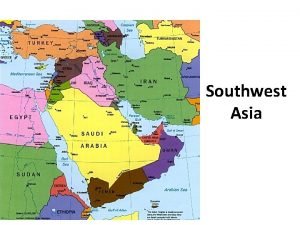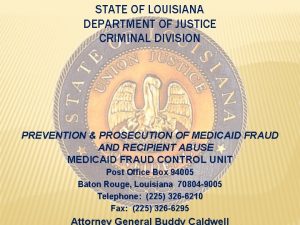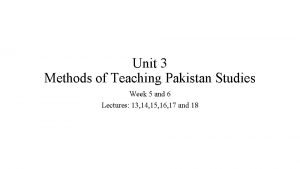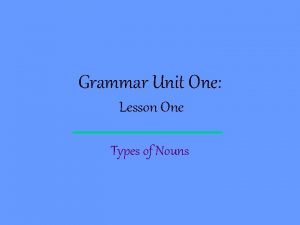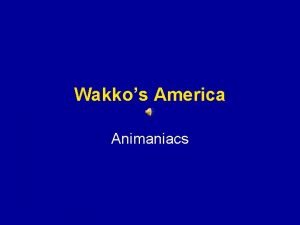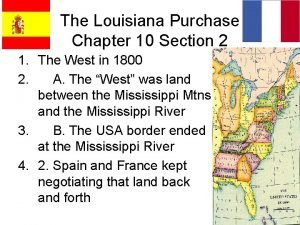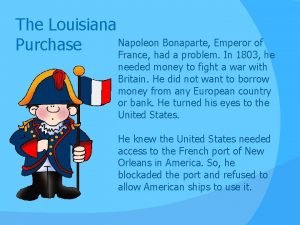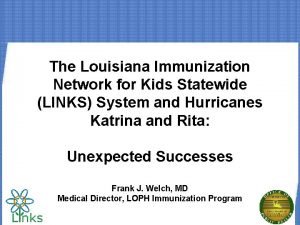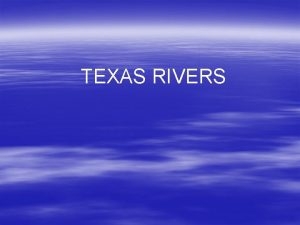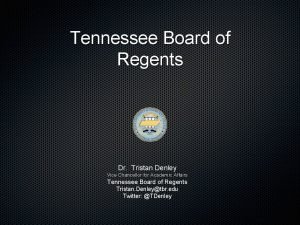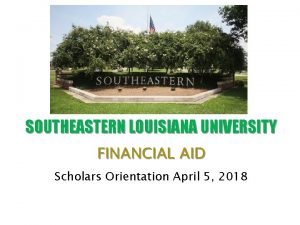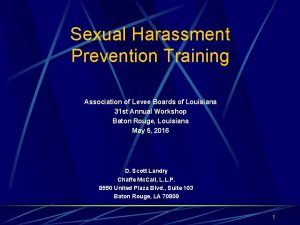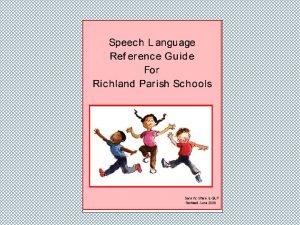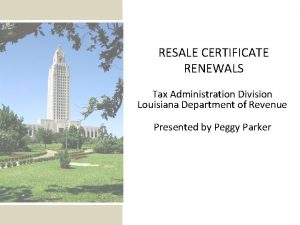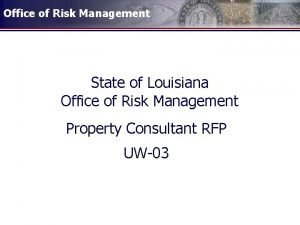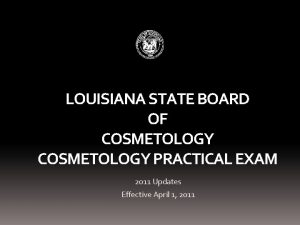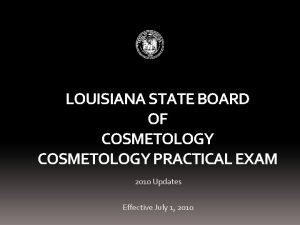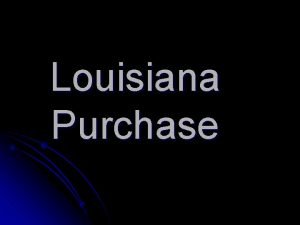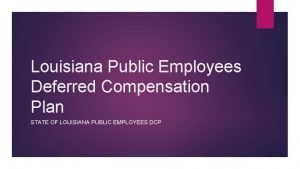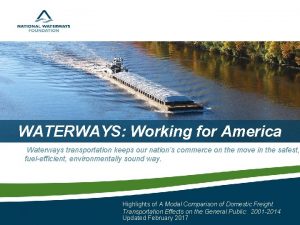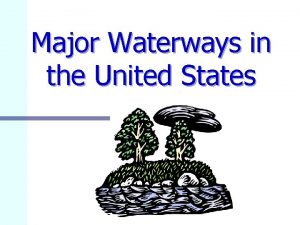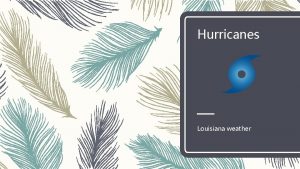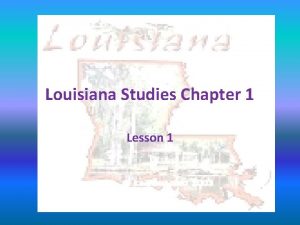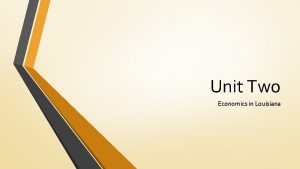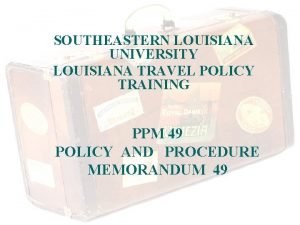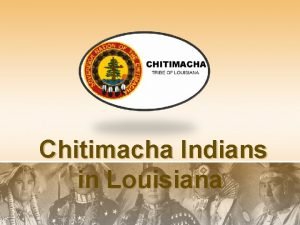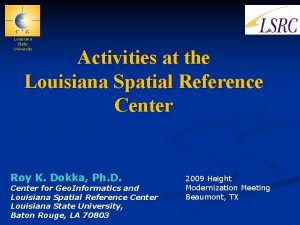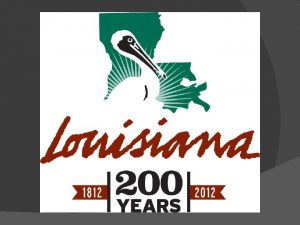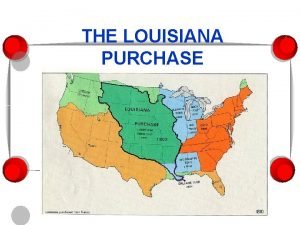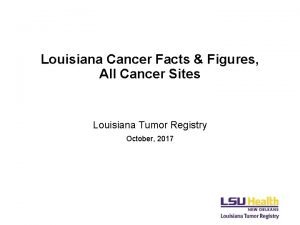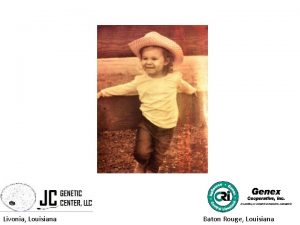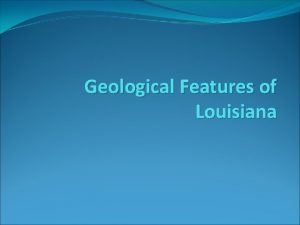LA Studies Unit One Louisiana Waterways UNIT ONE














































- Slides: 46

LA Studies Unit One

Louisiana Waterways UNIT ONE

Louisiana Waterways Louisiana has nearly 5000 miles of navigable waters to include rivers, bayous, creeks and canals. Navigable boat -- water deep enough for safe travel by

Rivers The State’s Most Important River Messipi, Rio del Espiritu Santo, River Louis Drainage basin covers more than 1, 245, 000 sq. miles Empties into the Gulf of Mexico

The Mississippi River basin carries 375 billion gallons of water through LA each day. Also brings 256 million tons of sediment down the river each year

The Red River The Second largest river drainage system in the state Formed Ends from several smaller waterways in Avoyelles parish, flows into Atchafalaya and Mississippi Rivers

Other Rivers The Pearl River The Little River The Calcasieu River The Tensas River The Sabine River The Ouachita River The Black River

The Atchafalaya River Native American Choctaw words meaning “long river” Long history of people trying to change and control its course

Check on Learning turn to page 40 Which river flows directly into Lake Pontchartrain? a. Tickfaw River b. Amite River c. Tangipahoa River d. Mississippi River

Lakes Man-Made Toledo Lakes: Bend Reservior Lake D’Arbonne in Union Parish Lake Claiborne in Claiborne Parish Sibley Lake in Natchitoches Parish Lake Chicot in Evangeline Parish

Lakes Natural Lake 625 Lakes Pontchartrain sq. miles but quite shallow Called a Tidal Lagoon, waters are Brackish Connects to the Gulf of Mexico

Lake Maurepas Located The west of Lake Pontchartrain two are connected by Pass Manchac Tidal Lagoon Brackish

Northwest Louisiana Caddo Cross Lake Bistineau

Other Lakes Bayou D’Arbonne Lake Catahoula Cocodrie Lake Calcasieu Grand Lake White Lake Verret Lake Salvador Lake Borgne

Cutoff Lakes Form when rivers seek shorter, straighter courses through flat terrain The former bends or curves in the river become lakes when the river moves to a straighter route

Cutoff Lakes When the Red River shifted its course away from the town of Natchitoches, it left behind a thirty-nine mile long cutoff lake. This scenic attraction is called the Cane River Lake. It can be confusing to call it both a river and a lake, but in its history it has been both.

Cutoff Lakes False River in Pointe Coupee Parish Lake Bruin in Tensas Parish Larto Lake in Catahoula Parish

Terms to know Bayou: a waterway that ranges in size from short and shallow, to long and navigable. The word bayou comes from the Choctaw native language and means “creek”. The French settlers called bayous “the sleeping water” in reference to bayous that are slow moving.

Terms to know Sediment: material that settles to the bottom of a liquid (lake/river). When the Mississippi flooded the land each year as part of its natural cycle, the sediment helped to create the rich agricultural land along its banks.

Terms to know Drainage Basin: an area of land that drains into tributaries and eventually into larger rivers Tributaries: smaller rivers and streams that flow into larger bodies of water

Terms to know Raft Lakes: lakes created when huge logjams blocked the flow of a river. A raft created by masses of logs, tree trunks, and other debris could literally block the flow of a river. The water would then overflow into nearby swamps, forming so-called raft lakes. Examples Caddo Lake and Lake Bistineau

Terms to know Marsh Lakes: Created behind low groups of ridges located in the marshlands that border Louisiana’s Gulf Coast. These ridges rise only slightly above the marsh, but they are dry enough to support the growth of live oak trees along their tops.

Marsh Lakes Chenier's: trap French term meaning place of oaks freshwater from the overflow of nearby rivers headed toward the gulf. The water collects behind the cheniers, creating marsh lakes.

Marsh Lakes The water remains fresh because the cheniers block the incoming saltwater that flows into the marsh from the Gulf. Examples: White Lake in Vermilion Parish, Grand Lake in Cameron Parish, and Calcasieu Lake in Calcasieu Parish

Check on learning What are four names given to our state’s most important river?

Check on learning Give one example of each of the following: Cutoff Raft Lake Marsh Lake

Louisiana's Cultural Regions

Region an area defined by similar features A physical region has similar climate and landforms A cultural region shares elements of culture

Check on learning What are elements of culture? Round. Robin

Louisiana can be divided into different cultural regions based on such factors or characteristics as ethnic heritage, language, religion, food, music, or recreation.

The Louisiana Department of Culture, Recreation, and Tourism has divided the state into five cultural regions

Five Cultural Regions Sportsman’s The Paradise Crossroads Cajun Country Greater New Orleans Plantation Country

Sportsman’s Paradise Region Also known as the Upland South Northern This Louisiana region of Louisiana has more in common with neighboring states than with south Louisiana

Sportsman's Paradise The heritage of early settlers to this area were Anglo -Saxon or Celtics Meaning or Irish that their ancestors were English, Scottish

Sportsman’s Paradise The northwest section has Shreveport-Bossier as its urban center (3 rd largest city in the state) These two cities are separated by the ______ but blend together into one urban culture

The northeast section has Monroe-West Monroe as its urban center These River two cities are separated by the Ouachita

Sportsman’s Paradise Abundant Lakes, outdoor recreation activities rolling hills, and forests Fishing, hunting, power boat racing, golfing

Check on Learning The City of Shreveport is located in which Cultural region? What are two characteristics used to identify a cultural region? Define the term urban. Define the term rural.

Crossroads Region Center of the State Merges North Louisiana and South Louisiana Rural (country) Areas Small towns that feature a Main Street Urban Center is Alexandria-Pineville

Cajun Country Region Triangle of South-west Louisiana Urban centers include Houma, Lafayette, Morgan City, and Thibodaux Most citizens of this region speak Cajun French

Prairie Cajun and Wetlands Cajun Prairie Cajun Culture (Acadia parish) is centered on agriculture and livestock Wetlands Cajun Culture (Lafourche parish) is centered on fishers and trappers

Cajun Country Though today the oil industry has brought cultural changes to both Prairie Cajun culture and Wetlands Cajun culture

Plantation Country Region Like its name suggests this region includes old plantation homes, live oak trees, and Spanish moss Many of these old plantation homes are national historic landmarks

Plantation Country Baton Rouge is the urban center of this region The State’s capital city has a mix of all people and lifestyles. Every ethnic group living in the state today is represented in Baton Rouge

The Greater New Orleans Region Urban center is the city of New Orleans The city is describe as being “cosmopolitan” an American city that is more like a European one. Busy port on the Mississippi River

The Florida Parishes The “toe of the boot” Called the Florida parishes because it was once a part of the colony of West Florida
 Chapter 21 physical geography of southwest asia
Chapter 21 physical geography of southwest asia Paradigm shift from women studies to gender studies
Paradigm shift from women studies to gender studies Louisiana medicaid fraud control unit
Louisiana medicaid fraud control unit Methods of teaching pakistan studies
Methods of teaching pakistan studies Unit 4 aos 2 legal studies
Unit 4 aos 2 legal studies Numerical datum crossword puzzle clue
Numerical datum crossword puzzle clue Business studies unit 1
Business studies unit 1 Social studies unit 2 test answers
Social studies unit 2 test answers Business studies unit 1
Business studies unit 1 Legal studies unit 1
Legal studies unit 1 One empire one god one emperor
One empire one god one emperor One one one little dog run
One one one little dog run One king one law one faith
One king one law one faith One empire one god one emperor
One empire one god one emperor One team one plan one goal
One team one plan one goal See one do one teach one
See one do one teach one One price policy
One price policy Twelfth night speeches
Twelfth night speeches Studiendekanat uni bonn
Studiendekanat uni bonn One vision one identity one community
One vision one identity one community Asean one vision one identity one community
Asean one vision one identity one community Unit one lesson one
Unit one lesson one Unit one lesson one
Unit one lesson one Unit 6 review questions
Unit 6 review questions Louisiana channel z
Louisiana channel z Tristan denley louisiana
Tristan denley louisiana Baton rouge louisiana indianapolis indiana
Baton rouge louisiana indianapolis indiana The louisiana purchase grade 10, 1200l
The louisiana purchase grade 10, 1200l Napoleon mii
Napoleon mii Links system louisiana
Links system louisiana What river separates texas and oklahoma
What river separates texas and oklahoma Tristan denley louisiana board of regents
Tristan denley louisiana board of regents Usi.8
Usi.8 Leonet selu
Leonet selu Louisiana sexual harassment training
Louisiana sexual harassment training Bermuda grass louisiana
Bermuda grass louisiana Serp.doe.louisiana login
Serp.doe.louisiana login Louisiana r-1064
Louisiana r-1064 Orm louisiana
Orm louisiana Marbury v madison louisiana purchase
Marbury v madison louisiana purchase Ppm 49
Ppm 49 Louisiana cultural regions
Louisiana cultural regions Louisiana tech university engineering
Louisiana tech university engineering Louisiana state board esthetician practical exam
Louisiana state board esthetician practical exam Louisiana state board esthetician practical exam
Louisiana state board esthetician practical exam Pros and cons of louisiana purchase
Pros and cons of louisiana purchase Louisiana deffered comp
Louisiana deffered comp
